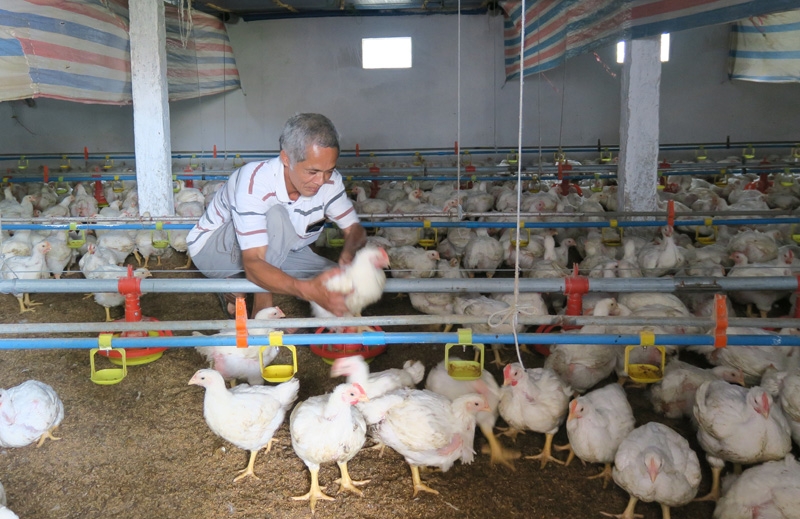
(HBO) - "Starting up my own business from 3,000 chickens, sometimes, I felt exhausted due to diseases, unstable prices, but with my determination, I have stayed well..." - Mr. Nguyen Dinh Lam, in the Village 3 / 2B, Thanh Lap Commune (Luong Son) shared this when taking us to visit the "silver billion" farm model of his family.

Mr. Nguyen Dinh Lam always maintained
thousands of chickens / litter
He planned a 3.5 hectare farm for planting
fruit trees, raising chickens, ducks, pigs, cows and fishponds.
In 2009, Mr. Lam started raising 3,000
chickens. With his careful and thoughtful care, together with the price of
chickens were up again so within a year his family has collected the interest.
With the additional capital, in 2011, Mr. Lam's family invested to expand 2
chicken farms with an area of 1,500 m2, each year raising 4 litters, each
litter obtains 10,000 chickens. He built a system of pig breeding facilities
with an area of 200 m2, to ensure the raising of 200 pigs / batch, 2 times a
year. Then, he still upgraded and repaired the ponds of 1.3 hectares for
raising fish, which made him each year collect 18 tons of commercial fish of
all kinds. The garden is grown in a variety of fruit trees, mainly bananas. The
fat and abundant banana trees, which cost less to care, each year also bring
his family the income of over 100 million VND.
When having accumulated the capital, Mr. Lam
invested in machinery to free the labor force. For example, with the task of
feeding livestock and poultry every day before, it was necessary to transport
about 60 packs of food from the warehouse to the feeders, but now, there is
only one worker standing up for operating the machine to pour the food to the
target feeders. With the help of machinery, in the past two years, Mr. Lam's
family only has to hire 4 workers. With less expenses, Mr. Lam's family gets
2.5 - 3 billion VND / year from this VAC farming model, 1 to 1.8 billion VND
after deducting all the expenses every year.
After 5 years of starting up his career with
VAC model, Mr. Nguyen Dinh Lam has become a "billionaire." He was
voted for "The Excellent Vietnamese Farmer in 2015" and the title
"For the career of developing agriculture,rural and Vietnamese
farmers".
According to data from the Hoa Binh Provincial Party Committee, the industrial production index for the first six months of 2025 is estimated to have increased by 20% compared to the same period last year. This marks the highest year-on-year growth rate for this period since 2020.
In the first six months of 2025, Hoa Binh province’s export turnover was estimated at 1.145 billion USD, marking an 18.11% increase compared to the same period in 2024. Import turnover was estimated at $ 804 million, a 17.15% increase, which helped the province maintain a positive trade balance.
The lives of the ethnic minority farmers in Tan Lac district have gradually improved thanks to the new directions in agricultural production. This is a testament to the collective strength fostered through the professional associations and groups implemented by various levels of the district’s Farmers’ Union.
With the motto the "product quality comes first,” after nearly one year of establishment and operation, Muong village’s Clean Food Agricultural and Commercial Cooperative, located in Cau Hamlet, Hung Son Commune (Kim Boi district), has launched reputable, high-quality agricultural products to the market that are well-received by consumers. The products such as Muong village’s pork sausage, salt-cured chicken, and salt-cured pork hocks have gradually carved out a place in the market and they are on the path to obtaining the OCOP certification.
In the past, the phrase "bumper harvest, rock-bottom prices" was a familiar refrain for Vietnamese farmers engaged in fragmented, small-scale agriculture. But today, a new spirit is emerging across rural areas of Hoa Binh province - one of collaboration, organisation, and collective economic models that provide a stable foundation for production.
Maintaining growing area codes and packing facility codes in accordance with regulations is a mandatory requirement for agricultural products to be eligible for export. Recently, the Department of Agriculture and Environment of Hoa Binh province has intensified technical supervision of designated farming areas and packing facilities to safeguard the "green passport" that enables its products to access international markets.



